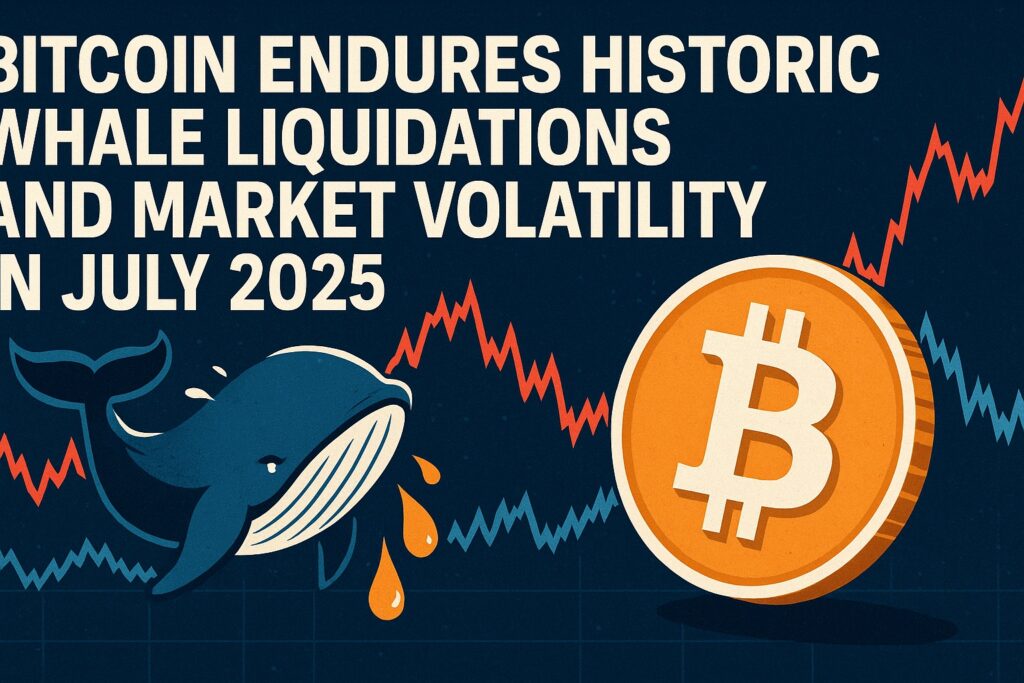July 2025 was one of the most tumultuous months in the history of digital assets. Rather than being driven by hacking scandals or macro‑economic collapses, volatility came from within the crypto ecosystem itself. The month was defined by a historic unwinding of long‑held Bitcoin positions, changing regulatory and institutional signals from the United States and Europe, and a resilient market that absorbed shocks and pointed toward the early stages of a new altcoin season.
Whale liquidations drive record selling pressure
The headline event of the month was a historic 80 000 BTC liquidation. On‑chain analysts trace the coins back to addresses created in 2011—during the so‑called “Satoshi era.” Over a decade of inertia, these coins had appreciated from roughly US$60 000 in total cost to around US$9.7 billion in market value. The entity controlling them—a long‑term holder believed to be an early miner or investor—began to move the entire stack in tranches through Galaxy Digital and subsequently to major exchanges such as Binance, Bybit, Coinbase and Bitstampcointelegraph.com. The sale represented the largest single notional Bitcoin liquidation in history, dwarfing the handful of large transfers associated with historic hacks or exchange collapseszerocap.com.

This liquidation occurred against the backdrop of broader profit‑taking. CryptoQuant’s data showed that realized profits on Bitcoin spiked to between US$6 billion and US$8 billion in late Julycointelegraph.com. That surge came from “new whales”—entities with more than 1 000 BTC that accumulated positions during the last two years and began to offload after Bitcoin breached US$120 000cointelegraph.com. The older whale’s 80 000 BTC sale, however, amplified market jitters because it indicated that early holders might also be cashing out.
The result was a flood of Bitcoin onto exchanges. On-chain analysts observed that wallets holding more than 1 000 BTC collectively sent more than 50 000 BTC to exchanges in a single day—setting multi‑month records for large inflowscointelegraph.com. The immediate price reaction was sharp but short‑lived: Bitcoin fell about 4 % as the coins hit the marketcointelegraph.com, briefly testing US$115 000zerocap.com. Yet by the end of the day prices had recovered, illustrating remarkable liquidity and depth. The ability of the market to absorb a US$9 billion sale without protracted capitulation underscored how far Bitcoin has matured since earlier cycleszerocap.com.
Market context behind the liquidation
Why did the early whale sell? Several factors converge:
- Price milestones and profit taking: Bitcoin’s rally above US$110 000 and US$120 000 was a psychological milestone. AI‑driven analytics from Token Metrics highlight that by early July, Bitcoin had surged past US$119 000 after breaching the critical US$110 000 resistance leveltokenmetrics.com and the bullish momentum signaled an opportunity for long‑time holders to cash out.
- Institutional liquidity: The rise of spot Bitcoin ETFs and deep derivatives markets provided avenues for whales to offload large positions without collapsing the price. Exchange reserves have fallen from 3.25 million BTC to 2.55 million BTC, indicating more coins are being moved into cold storage rather than ready to selltokenmetrics.com. That drop reduces immediate supply and increases the price elasticity when large orders hit the market.
- Diversification and estate planning: Media reports suggest the whale was an early adopter planning an estate transfer. By liquidating in 2025, the holder could diversify into less volatile assets while ensuring heirs receive realized gains rather than illiquid private keys.
The liquidation may therefore be less an indictment of Bitcoin than a reflection of a maturing ecosystem where even enormous positions can find liquidity and where early adopters can exit without derailing the market.
Regulatory shifts and institutional signals
July 2025 also brought major policy developments. On 30 July 2025 the White House released its first comprehensive crypto strategy under Executive Order No. 14178. According to RevenueBot’s summary of the report, the U.S. government:
- Opposes issuing a central bank digital currency (CBDC)revenuebot.io.
- Discusses designating 200 000 confiscated BTC as part of a national crypto reserverevenuebot.io—an unprecedented acknowledgment of Bitcoin as a strategic asset.
- Proposes stablecoin reform with new licensing requirements, access to Federal Reserve payment systems and strict asset‑backed guaranteesrevenuebot.io.
- Calls for simplified regulation across the SEC, CFTC and FDIC to eliminate jurisdictional confusion and accelerate industry growthrevenuebot.io.
- Identifies Bitcoin and XRP as strategic priorities for future policyrevenuebot.io.
The report signaled a departure from earlier, more hostile positions by embracing the idea of a U.S. Bitcoin reserve and clarifying stablecoin and ETF rules. The expected impact, according to analysts, includes increased institutional investment and strengthened market confidencerevenuebot.io. Indeed, spot Bitcoin ETFs continued to see record inflows, with total net inflows exceeding US$25 billion by Q3 2025tokenmetrics.com.
These policy shifts coincided with a broader pro‑crypto environment in Washington. The new SEC chair Paul Atkins declared Ethereum is “not a security”zerocap.com, removing regulatory uncertainty over the second‑largest cryptocurrency. At the same time, large financial institutions, including JPMorgan, explored crypto‑backed loanszerocap.com. Payments adoption accelerated in sectors such as gaming and travelzerocap.com, while companies like Trump Media added US$2 billion in BTC to their balance sheetszerocap.com.
Market resilience and the rise of altcoins
Despite the selling pressure from whales, Bitcoin’s price remained resilient. During the last week of July, Bitcoin traded within a narrow 5 % range of US$114 750–US$120 250, with intraday dips being quickly boughtzerocap.com. Zerocap’s market wrap noted that after the 80 000 BTC sale pushed prices to US$115 000, bulls reclaimed the range by day’s end, demonstrating a structural bid and market maturityzerocap.com. The ability of Bitcoin to absorb a US$9 billion liquidation has been interpreted as evidence that the asset is no longer susceptible to catastrophic single‑seller events.
This period also marked a capital rotation into altcoins. Bitcoin dominance declined from roughly 64 % to around 60 % as investors sought higher‑beta assets. Zerocap observed that while Bitcoin consolidated, Ethereum, Solana and other altcoins outperformed. Ethereum notched 13 green days out of 15, reaching US$3 900—its highest level since early 2025zerocap.com. Altcoins like SOL surged more than 8 % in a single sessionzerocap.com. RevenueBot’s monthly recap similarly highlighted strong gains across ETH (+60 % in July), BNB (+30 %), XRP (+49 %), Solana (+25 %), Dogecoin (+49 %) and Cardano (+60 %)revenuebot.io. Technical patterns on XRP (breaking a multi‑year resistance), Solana (exiting a symmetrical triangle) and Cardano (forming a rising wedge) reinforced optimismrevenuebot.io.
Observers labelled this rotation the start of altseason—the phase of the crypto cycle where capital flows from Bitcoin into smaller-cap tokens. Analysts pointed to several catalysts:
- Institutional diversification: Investors, including corporate treasuries and ETF managers, began seeking exposure beyond Bitcoin. Spot Ethereum ETFs recorded a US$3.1 billion inflow in a single dayzerocap.com, while expectations grew for XRP and Solana ETFsrevenuebot.io.
- DeFi and Layer 2 innovations: Developments in Bitcoin Layer 2 and decentralized AI agents broadened the ecosystemrevenuebot.io, encouraging experimentation with smaller projects.
- Token unlocks and price swings: Over US$96 million in tokens were unlocked across projects such as AltLayer, Avail and Venom, increasing short‑term trading volume and risk appetiterevenuebot.io.
While altcoins rallied, analysts cautioned that their higher beta made them vulnerable to sharp pullbacks; on July 25, when Bitcoin briefly dipped, ETH dropped 3 % and Solana fell 8 %, before recoveringzerocap.com. Nevertheless, the overall trajectory showed strengthening breadth, with the altcoin market cap breaking higher and Bitcoin dominance trending lowerzerocap.com.
Macro‑economic backdrop and forward outlook
Macro conditions in late July added another layer to the market narrative. On the economic front:
- US–EU trade agreements eased tariff fears, boosting risk sentiment and sending the S&P 500 to new highszerocap.com. Bitcoin followed equities higher and retested the top end of its rangezerocap.com.
- Central banks signalled rate cuts were on the horizon. The Federal Reserve gave little guidance, but markets priced in a possible rate cut in September, while the European Central Bank held rates steadyzerocap.comzerocap.com.
- The People’s Bank of China maintained its loan prime rates amid a robust 5.2 % year‑over‑year GDP growthzerocap.com.
These macro signals reinforced a risk‑on environment where investors were willing to buy dips in both equities and crypto. On‑chain metrics also improved; exchange reserves continued to decline and the 90‑day annualised basis for Bitcoin futures climbed toward 10 %, indicating stronger demand for leveraged longszerocap.com. Ethereum’s basis also increased to 7.48 %zerocap.com. With macro volatility expected to pick up around the Fed’s next meeting, Zerocap suggested that short‑dated options were underpriced relative to the pace of spot movements, hinting at potential opportunities for derivatives traderszerocap.com.
Looking forward to August 2025, analysts remain cautiously optimistic. RevenueBot’s forecast envisions political signals from the U.S. continuing to shape global regulation, with Bitcoin’s potential status as a strategic reserve asset challenging goldrevenuebot.io. Institutional momentum is expected to build as the market awaits decisions on XRP and Solana ETFs and new altcoin‑based fundsrevenuebot.io. Innovations in asset tokenization and decentralized AI could drive further adoption, while major corporations like PayPal, Amazon and AliExpress integrating crypto payments may pivot digital assets from speculative investments toward functional payment instrumentsrevenuebot.io.
Risks
Despite the bullish outlook, several risks remain:
- Regulatory ambiguity outside the U.S.: While American policy has turned favourable, Europe and parts of Asia continue to propose heavy taxation and trading restrictions, which could weigh on global adoptiontokenmetrics.com.
- Environmental concerns: Bitcoin’s proof‑of‑work consensus continues to attract criticism for its energy consumptiontokenmetrics.com. Stricter ESG mandates could limit institutional participation or accelerate shifts toward proof‑of‑stake assets.
- Price corrections: After such strong gains, 15–25 % pullbacks are considered normal in bull cyclestokenmetrics.com. Investors should be prepared for volatility, particularly as whales continue to rebalance and as macro‑economic policy decisions approach.
Conclusion
July 2025 will be remembered as a watershed month for cryptocurrencies. The historic liquidation of an 80 000 BTC trove triggered the largest single selling event in Bitcoin’s history, but the market’s ability to absorb the supply shock underscored how far digital assets have matured. Realized profits worth billions of dollars and large inflows from whales signaled a phase of profit‑taking, yet Bitcoin’s rapid recovery, supported by robust institutional demand, improved regulatory clarity and growing liquidity, prevented a cascading sell‑off. Altcoins seized the spotlight as capital rotated down the risk curve, with Ethereum, XRP, Cardano and others posting double‑digit gains.
The month’s regulatory and macro‑economic developments—such as the White House’s crypto strategy opposing CBDCs and proposing a national Bitcoin reserve, the SEC clarifying Ethereum’s status, and major corporations adopting crypto—reinforced confidence that digital assets are becoming mainstream. While risks remain, particularly around future regulatory regimes and typical bull‑market corrections, the narrative emerging from July suggests that the cryptocurrency market is entering a new phase: one defined by resilience, diversification and institutional legitimacy rather than by speculation alone.
Table 1 – Key metrics from July 2025 (approximate values)
| Metric | Value/Range | Source |
|---|---|---|
| Size of dormant whale sale | 80 000 BTC (~US$9.7 billion) | Cointelegraph on-chain analysiscointelegraph.com |
| Realized profits spike | US$6 – 8 billion in late July | CryptoQuant data via Cointelegraphcointelegraph.com |
| Bitcoin trading range (late July) | US$114 750 – US$120 250 | Zerocap Spot Deskzerocap.com |
| Bitcoin dominance (approx.) | 60 % after decline from 64 % | Zerocap market commentaryzerocap.com |
| Ethereum July performance | +60 %, price ~US$3 900 | RevenueBot monthly recaprevenuebot.io |
| Other notable altcoin gains | BNB +30 %, XRP +49 %, Solana +25 %, Dogecoin +49 %, Cardano +60 % | RevenueBotrevenuebot.io |
| Proposed U.S. Bitcoin reserve | 200 000 confiscated BTC to be held as a national reserve | U.S. crypto strategy summaryrevenuebot.io |
| Exchange reserves trend | Fall from 3.25 million BTC to 2.55 million BTC (2017 levels) | Token Metrics analysistokenmetrics.com |









